Mesmeromania, or, the Tale of the Tub
The therapeutic powers of animal magnetism
Christopher Turner
Perhaps the history of the errors of mankind, all things considered, is more valuable and interesting than that of their discoveries. Truth is uniform and narrow; it constantly exists, and does not seem to require so much an active energy, as a passive aptitude of soul in order to encounter it. But error is endlessly diversified; it has no reality, but is the pure and simple creation of the mind that invents it. In this field the soul has room enough to expand herself, to display all her boundless faculties, and all her beautiful and interesting extravagancies and absurdities.
—Benjamin Franklin, Report of Dr. Benjamin Franklin, and other commissioners, charged by the King of France, with the examination of the animal magnetism, as now practised in Paris (1784)
In a medical museum in Lyon there is a strange tub-like object constructed of oak and decorated with lengths of ornately woven rope. About six inches in from the rim, eight evenly spaced iron rods sprout up from a highly polished lid. In the eighteenth century, a group of patients would sit or stand around this device in such a way as to press the afflicted areas of their bodies against these moveable metal wishbones and, bound to the instrument by the ropes, would link fingers to complete an “electric” circuit. The atmosphere in which these sessions took place was heavy with incense and séance-like; the music of a glass harmonica (invented by Benjamin Franklin) provided a haunting soundtrack, and thick drapes, mirrors, and astrological symbols decorated the opulent, half-lit room.
Franz Anton Mesmer, the legendary Viennese healer, hypnotist, and showman, would enter this baroque salon of his own invention wearing flamboyant gold slippers and a lilac silk robe. He would prowl around the expectant, highly charged circle, sending clients into trances with his enthralling brown-eyed stare. By slowly passing his hands over patients’ bodies, or with a simple flick of his magnetized wand, Mesmer would provoke screams, fits of contagious hysterical laughter, vomiting, and dramatic convulsions. These effects were considered cathartic and curative. When a patient’s seizures became so exaggerated as to be dangerous or disruptive, Mesmer’s valet, Antoine, would carry him or her to the sanctuary of a mattress-lined “crisis room” where the screams would be muffled.
The baquet, as Mesmer named his vessel, parodied the contemporary craze for medical electricity. Pharmacists and apothecaries frequently prescribed shock treatment, especially in attempts to cure paralysis, and often exposed the sick to a more general “electrical aura” as a healing agent. Benjamin Franklin, then American ambassador to France, was fond of demonstrating the power that could be harnessed in a Leyden jar, the prototype of the modern battery, by using one to send a bolt of electricity through a chain of people. (One medical electrician claimed not only to have shot a charge through 150 guardsmen, but to have made a kilometer-long line of monks simultaneously jump into the air.) Some animals were electrocuted in public displays of electricity’s magical and invisible power; others were drowned and immediately revived with galvanic current. One poor boy was repeatedly thrown into a vat containing a large electric eel until he was cured of an irregular use of his limbs. In comparison to these torture treatments, Mesmerism—or “animal magnetism”—seemed to offer a less violent, and no less miraculous, form of therapy.
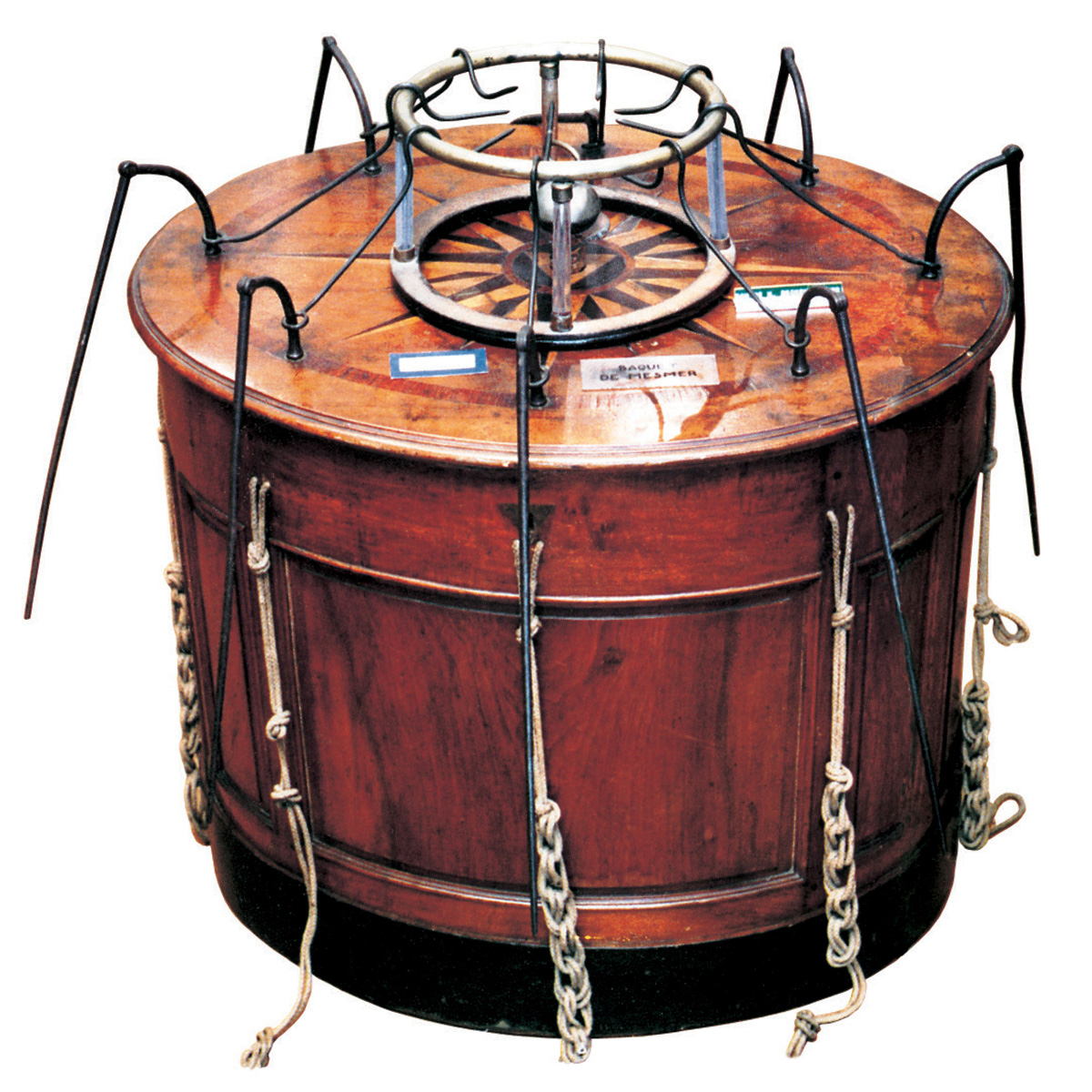
Mesmer believed that the human nervous system was made up of a subtle, invisible fluid—analogous to electricity but operating according to “hitherto unknown” laws—that was subject to the ebb and flow of planetary influence much like ocean tides. For Mesmer, a healthy man was essentially an electrical machine in harmony with the energies of the cosmos. He believed that sickness was caused by the obstruction of the free flow of radiant fluid in the body and that he could restore a natural equilibrium in his patients with the powers of his own animal magnetism. To transfer this healing current, Mesmer would sit with patients’ legs squeezed between his knees, press their thumbs in his hands, stare intensely into their eyes, and stroke their limbs to manipulate their internal ether. He claimed to have cured many ailments in this fashion, and to have restored the sight of a court pianist who had been blind since the age of three.
This latter claim was much disputed (the pianist seemed to be able to see only when Mesmer was in the room), and Mesmer left Vienna for Paris in 1778 amid controversy and accusations of fraud. “I was being taxed with eccentricity,” he wrote in Memoir on the Discovery of Animal Magnetism, which was published the following year, “my tendency to quit the normal path of Medicine was being construed as a crime.” However, his reputation and fame as an extraordinary healer prevailed, cemented upon publication of the Memoir, in which Mesmer recounted his therapeutic successes and outlined the twenty-seven principles of animal magnetism, which his followers came to call “The Doctrine.”
Mesmer was soon besieged by more patients than he could hope to treat individually, as many as two hundred a day, so on arriving in Paris he invented the baquet to accommodate them en masse. A few years earlier, he had discovered that the powers of his own animal magnetism were magnified if he stood with one foot in a pail of water with an iron rod dipped into it. The baquet was essentially a gigantic bucket, a huge Leyden jar supposedly charged by the animal magnetism emanating from Mesmer’s own person. Mesmer believed that animal magnetism “could be stored up and concentrated, like electric fluid” and that with the aid of the magnetic reservoir in his therapeutic prop he could distribute the full force of his own peculiar “vital fire” to a burgeoning clientele. In fact, the hysterical reactions Mesmer provoked seemed to be contagious, so the dramatic effects were exacerbated in a crowded room. Some baquets could seat twenty people, and Mesmer had four of these in his Paris treatment rooms at the Hôtel Bullion on rue Coq-Héron.
The fashionable and the curious flocked to Mesmer’s clinic to see and experience the miraculous transformation it promised (the novelist Stefan Zweig described this “collective frenzy” as “Mesmeromania”). Benjamin Franklin remarked that the public’s attention was divided equally between the baquet and the new hot air balloon, and wrote of the craze: “Struck with the clearness and accuracy of [Mesmer’s] reasonings, the magnificence of his pretensions, and the extraordinary and unquestionable cures he performed, some of the greatest physicians and most enlightened philosophers of France became his converts.“”In 1784, George Lafayette, the French soldier and statesman, wrote to George Washington of his enthusiasm for Mesmer. “I know as much about it as any sorcerer ever did. Before leaving I will obtain permission to let you into Mesmer’s secret, which, you can count on it, is a great philosophical discovery.”
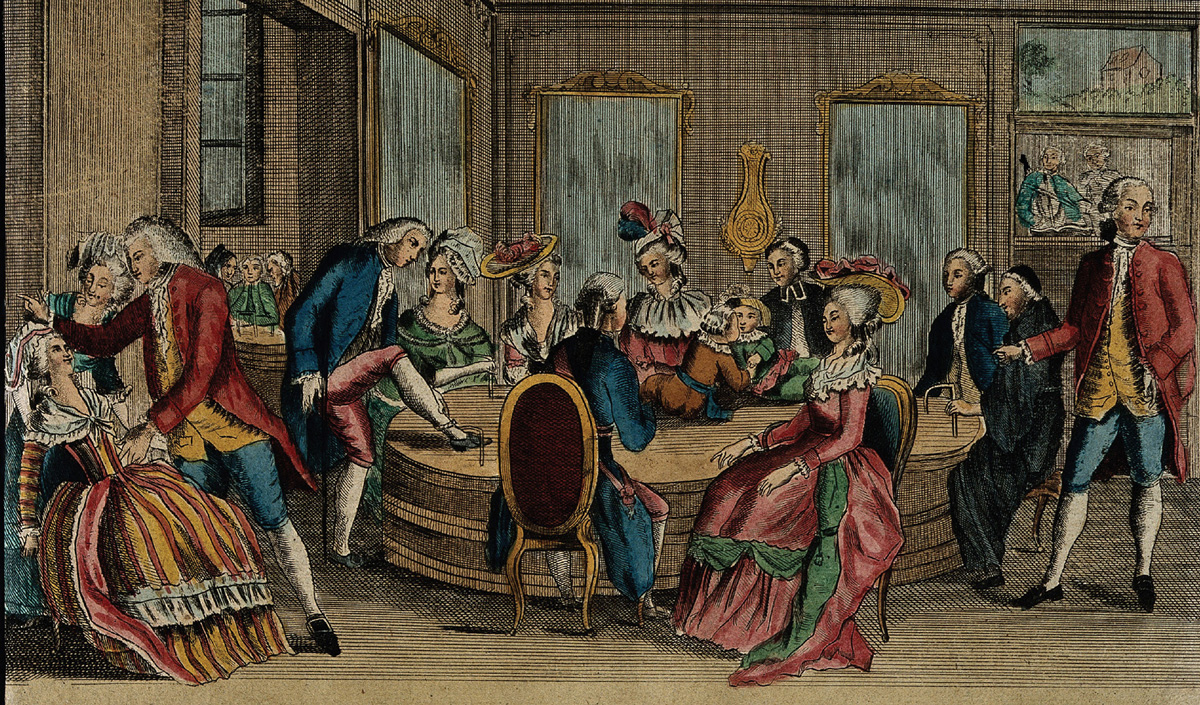
For his part, Mesmer was speedily converting metropolitan hypochondria and ennui into, as he put it, “a steady stream of silver.” Though one of his four tubs was for the exclusive use of the poor at no cost, seats around the other baquets had to be reserved far in advance and cost roughly the same as desirable tickets to the opera. For his most aristocratic patients Mesmer also supplied miniature versions of his famous tubs, which they could use in the privacy of their own homes. To further satisfy the public’s insatiable demand for treatment—he wanted all of humanity to benefit, but the needy were cluttering up his treatment rooms—Mesmer also magnetized trees, to which people would bind themselves in the hope of achieving the same curative effect.
Mesmer also initiated a training program, establishing a Society of Universal Harmony whose members paid handsomely to be initiated into the mysteries of his esoteric technique. Nicolas Bergasse, a philosopher, lawyer, and hypochondriac from Lyon who was the Society’s first member, wrote a complicated and occult instruction manual, which was only decipherable with a key of cabbalistic signs. On the eve of the French Revolution, the Society had 430 graduates, with thriving satellite organizations in every major French city (6,000 unsanctioned Mesmerists operated in and around Paris alone in 1785).
Surprisingly, given their apparent popularity, the baquet in the Lyon museum is thought to be the only surviving example of Mesmer’s group therapy machines. It was acquired in 1846 by a Bavarian furrier who prised off the lid to find that on the inside the eight protruding rods were inserted into eight cylinders, each of which had a powerful magnet at its base. The tub still contains two layers of sixteen bottles, arranged in a radial pattern on a bed of crushed glass, pounded sulfur, and iron filings; watermarks indicate that the vat would also have been filled to the brim with magnetized water.
Mesmer’s miraculous cures were probably attributable to his own suggestive powers rather than to any of the baquet’s hidden secrets. However, when the furrier opened the vessel he discovered more than the apparatus described above; years later a group of historians analyzed these findings and concluded that some intriguing embellishments had been made toward the end of the eighteenth century in an attempt to increase the efficacy of an otherwise useless device. A Leyden jar had been inserted in the middle of the baquet so that the iron rods might actually pack a real and powerful jolt, and cornflowers, a folk remedy for weak eyes, were sprinkled liberally over the iron filings and bottles inside.
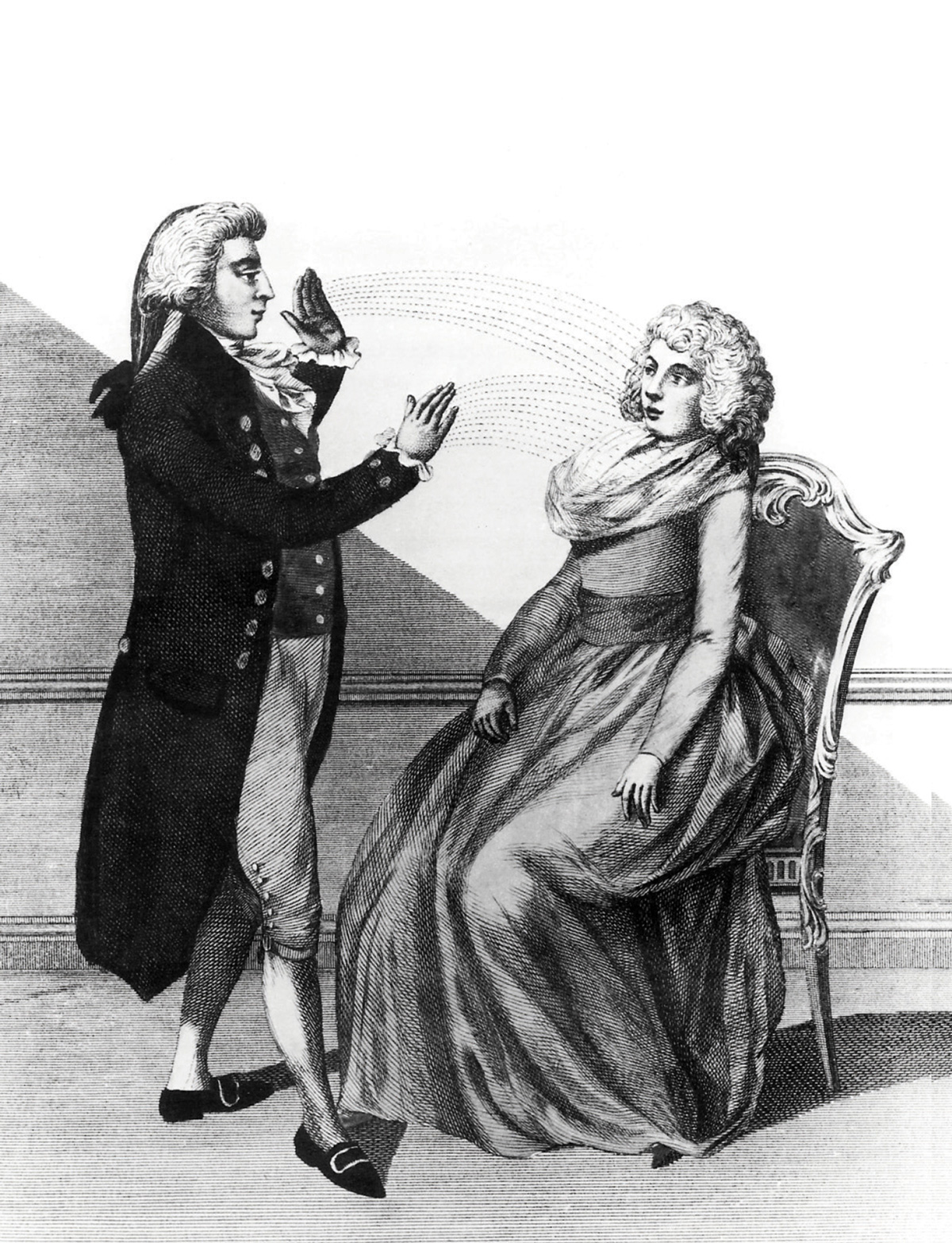
The Lyon Mesmerist society, La Concorde, was closely allied to the Masons, from which most of its members were recruited, which explains why the lid of the baquet is decorated with Masonic symbols: a radiating sun with a pyramid embedded in its core, from which the copper ball of the Leyden jar emerges like an all-seeing eye. The cornflowers, too, might be interpreted symbolically—not as a cure for failing eyesight but as triggers for the interior vision that a session at the tub was thought to inspire. The lyonnais Mesmerists purported that their patients could see their own insides when in somnambulistic trances, and thereby make uncannily accurate self-diagnoses.
Despite the popularity and rapid proliferation of Mesmerism, Mesmer’s science never received the official recognition he craved. “I dare to flatter myself,” Mesmer boasted in his Memoir, “that the discoveries I have made will push back the boundaries of our knowledge of physics as did the invention of microscopes and telescopes for the age preceding our own.” Imagine his displeasure, then, when the Academy of Sciences, whose members were invited to witness his miraculous cures, rejected his principles as “destitute of foundation and unworthy of the smallest attention.” (Mesmer is frequently acknowledged as a pioneer in the territory of the modern unconscious, but it was only in 1882, when Charcot gave a lecture to the Academy of Sciences on his investigations of hysteria, that the therapeutic potential of hypnotism was formally admitted.)
The Academy not only dismissed Mesmerism as quackery, but saw in it a dangerous, morally corrupting force. There were frequent insinuations of sexual impropriety; Thomas Jefferson, who was living in Paris at that time, considered Mesmerism “an imputation of so grave a nature as would bear an action at law in America.” The erotic implications of Mesmerism were satirized in popular songs and salacious cartoons, which fixated on the debauched, comic scenes around Mesmer’s tubs, the mysteries of the sound-proofed crisis room, and the risqué nature of mesmeric massage, which focused on the upper abdomen. One contemporary illustration depicts Mesmer, his pockets bulging with money, with the ass’s head of the charlatan, practicing his sexual magic on a beautiful woman who has clearly fallen under his seedy spell.
In 1784, the King of France set up a royal commission to investigate Mesmer. That year a young man broke into Louis XVI’s bedroom, threw himself at the king’s feet, and begged him to exorcise the “demon that possesses me.” “It’s that knave Mesmer who has bewitched me,” he wailed. Given that Marie-Antoinette was a frequent patron of the baquet, the king probably had a more pressing reason to gauge any real threat to public morality. When Mesmer threatened to go into exile in 1781 because he felt his discovery was not suitably appreciated in France, Marie-Antoinette offered him a substantial pension of 20,000 francs and an annual salary of 10,000 more to stay, on condition that he train three government pupils in his technique. Mesmer wrote an ungracious public letter to the queen rejecting the proposal and suggesting a sum closer to 400,000 francs.
The royal commission, headed by Benjamin Franklin, comprised several of the leading scientists of the time: the chemist Lavoisier; the astronomer Bailly; and the physician Dr. Guillotin (the inventor of an altogether more macabre device with which, ironically, Lavoisier and Bailly were executed a few years later). Mesmer refused to cooperate with this select group, but one of his pupils, Charles D’Eslon, also the physician to the King’s brother, the Comte d’Artois, gave them full access to his own practice.
“Some of the patients look peaceful and sit very still as if in a trance,” the commission wrote of the scene they witnessed around the baquet, “others cough and spit; others say that they experience a slightly painful sensation, or a feeling of warmth pervades the body and causes sweating; yet others are seized with convulsions. These convulsive attacks are extraordinarily frequent, violent, and last an unusually long time. No sooner is one patient seized with convulsions than other patients begin to manifest the same symptoms. The commission has itself witnessed convulsive attacks that lasted three hours. The sufferer exudes a cloudy and slimy liquid, so overpowering are the physical exertions he undergoes; and at times a few traces of blood may be found. The limbs and the whole body are contorted by the most violent movements, so that there are spasms of the larynx, twitching of the abdomen, of the stomach, fixity of the eyes, shrill cries, groans, fits of weeping and laughing.”
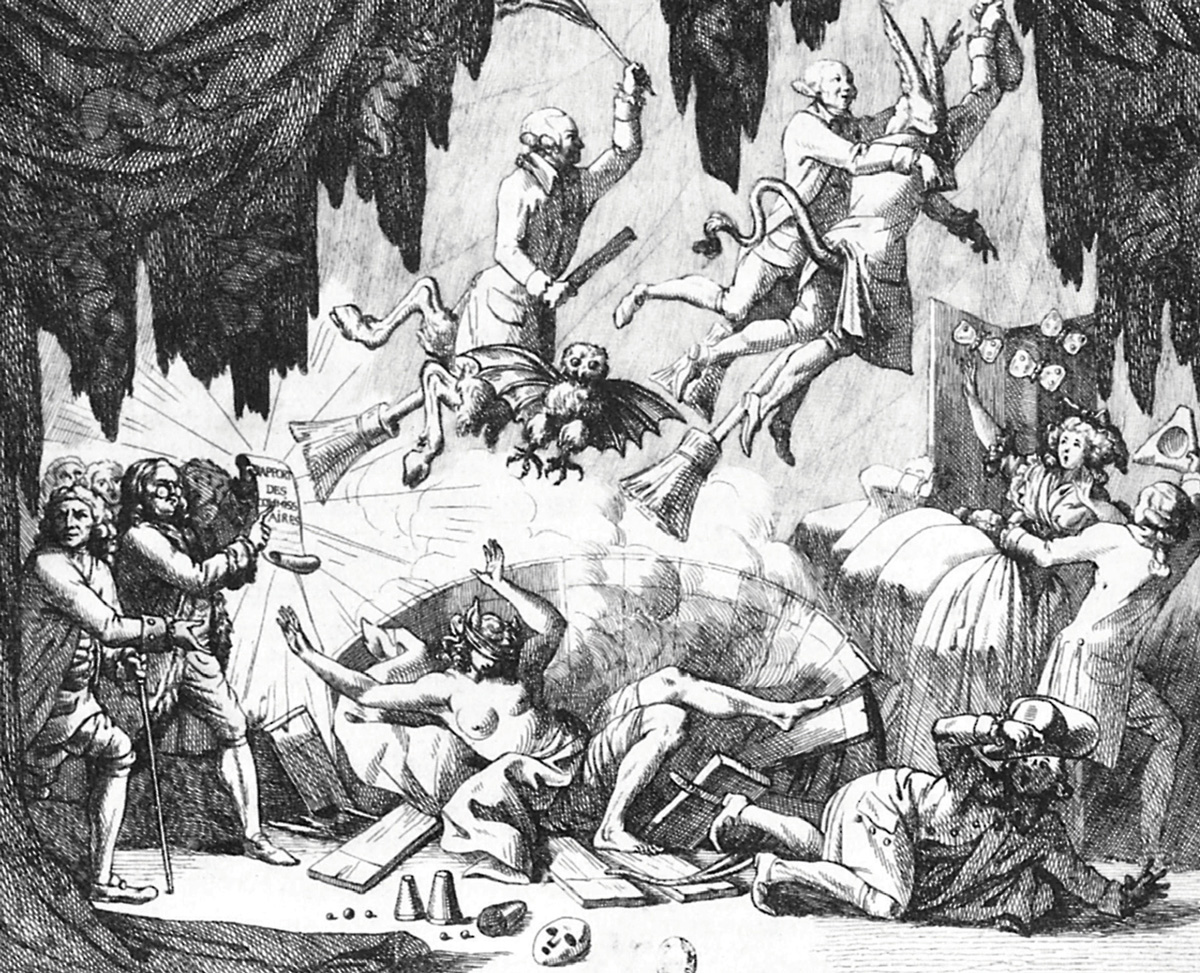
Despite these official refutations, Mesmer’s followers maintained their belief in the baquet as a mystical panacea that would end all human suffering. As the historian Robert Darnton has shown, there was a radical strain in Mesmerism that one might miss in engravings of languid aristocrats crowding around the baquet hoping for a cure for gout: “To those who had lost faith in the old system,” writes Darnton, “[M]esmerism offered a new faith, a faith that marked the end of the Enlightenment, the advent of the Revolution, and the dawning of the 19th century.”
The baquet fermented radical ideas and political hysteria, even as, and largely because, Mesmer was officially snubbed, which led many to empathize with his persecution. Following his rejection by the governing bodies, Mesmer proclaimed, “It is to the public that I appeal!” His Society of Universal Harmony—whose motto was “go forth, touch, cure”—became a locus of anti-government speeches, arousing the attention of the police and causing one of the king’s ministers to propose expelling Mesmer from France. The removal of blockages from the sick body to allow the free flow of mesmeric fluid became a metaphor for the cleansing from the body politic all barriers to freedom: A corrupt, artificial, and decadent society would be shaken up for the better by mesmeric convulsions.
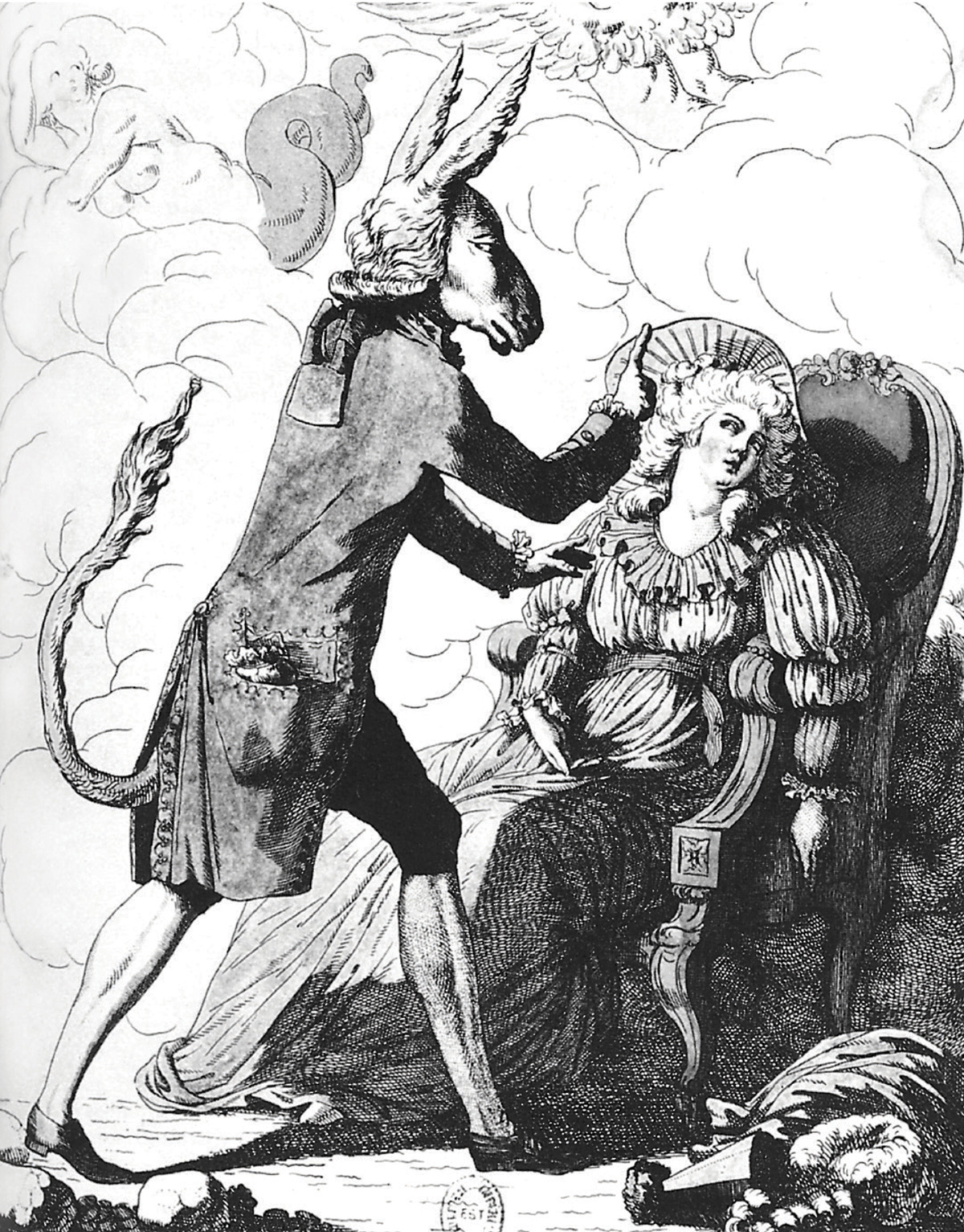
Mesmer left Paris soon after the publication of the commissioner’s damning report, a few years before the storming of the Bastille. A satirical engraving, Magnetism Unveiled, 1784, depicts Franklin and his commissioners brandishing their report and Mesmer fleeing with his loot on a witch’s broom; the figure of truth has tumbled from the sky to crush the fraudulent baquet. Mesmer wandered through France, touring his provincial Societies (including Lyon, where he may have presided over a séance at the last surviving tub), before moving on to Germany and Austria. He finally assumed a voluntary exile in Switzerland, only a few miles from his birthplace, and wrote two further books about his rejected discovery. He died in 1815, at age eighty-one.
It seems that Mesmer never lost his charismatic touch. A young historian visited him the year he died and sat opposite him, “knee to knee,” transfixed by Mesmer’s “flashing and deeply penetrating gaze.” Mesmer gently stroked the contours of the visitor’s body before pressing his thumbs into the pit of the man’s stomach to induce “strong coughing with plentiful expectoration.” Mesmer, who also happens to have commissioned Mozart’s first opera, then comforted the drowsy youth with a “masterly performance on the glass harmonica.”
Christopher Turner is an editor of Cabinet and is currently writing a book, Adventures in the Orgasmatron: How the Sexual Revolution Came to America, to be published by Farrar, Straus and Giroux.